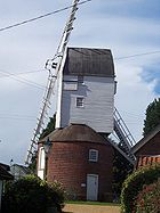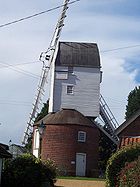
Framsden
Encyclopedia

Ipswich
Ipswich is a large town and a non-metropolitan district. It is the county town of Suffolk, England. Ipswich is located on the estuary of the River Orwell...
and 3 miles (5 km) south of the small market town of Debenham
Debenham
Debenham is a large village and civil parish in the Mid Suffolk district of Suffolk in Eastern England. In the 2001 census the population recorded was 1,728...
, Suffolk
Suffolk
Suffolk is a non-metropolitan county of historic origin in East Anglia, England. It has borders with Norfolk to the north, Cambridgeshire to the west and Essex to the south. The North Sea lies to the east...
.
The B1077 runs through the west of the Parish and the A1120 cuts across the north of the Parish.
The majority of homes are situated along Framsden Street with smaller clusters at Peats Corner, along the A1120 and St John’s Row in addition to more scattered houses towards Otley and Cretingham.
There is also a significant number of more remote farmhouses and tenant farms of the Helmingham Estate.
The total population of Framsden in the census of 2001 was 299, with 125 households, 52 people under 16 years, 201 of working age and 46 over 65 years.
All essential services can be accessed at Debenham, including the High School.
Framsden is mostly within the Helmingham
Helmingham Hall
Helmingham Hall is a moated manor house in Helmingham, Suffolk, England. It was begun by John Tollemache in 1480 and has been owned by the Tollemache family ever since. The house is built around a courtyard in typical late medieval/Tudor style....
Estate and a lot of property is tenanted. These are traditional estate 2 bedroom cottages or large farmhouses which are sometimes rented as temporary accommodation.
The village is surrounded by arable farmland but enjoys one of the greatest lengths of public footpaths (around 16 miles) for its size and has conservation areas of ancient meadow and veteran trees. The hedgerows are plentiful and, away from the road, are only trimmed every 3+ years, affording pleasant walking and harvesting of hedgerow fruits.
The Helmingham Estate’s management of much of Framsden’s arable land includes preserving veteran trees, ancient hedgerows, old ponds and ancient meadows rich in plant and wildlife diversity. These achievements have been acknowledged this year by the estate farm winning the FWAG (Farming and Wildlife Advisory Group) Conservation Award for “high level of commitment shown to the principles and delivery of conservation, combined with good farming – an innovative approach to cultivations based on minimum tillage across the whole farm”.
Framsden has an attractive pub - The ‘Doberman Inn’. Memorable events include the hosting of Morris dancers and twinning events with St Etienne de Lisse. For several years in the 1990s the village also hosted a lively steam event and Street Fair. The village shop and Post Office on the street was lost in the early 90’s.
Framsden is fortunate to host the Helmingham Primary School and Old Schoolhouse Nursery on the edge of the village; accessible by footpath and drawing children from the local villages. We have a Mother and Toddler Group, which meets weekly on a Wednesday morning during term times in the village hall. The Old School House Nursery in Helmingham (next door to the primary school) takes children from 2 years upwards from a number of local villages and acts as a feeder to Helmingham County Primary School. This summer the school won the East Anglian Daily Times first prize for the best school garden.
We have a small village hall, refurbished 15 years ago, hosting village activities and events. Framsden has a parish church, St Mary’s, in the centre of the village, and a Baptist Chapel at the bottom of Jockey’s Lane near the junction of the A1120 and the B1077. The historic St Mary’s Church has been a successful concert venue in the past and the Baptist Chapel runs a ‘Friday Club’ for children and young people of the area.
The play area was renovated in 2003 for the younger people of the village by local fundraising and the commitment of the parish councillors.
The estate cottages and school were designed 150 years ago by Lord John Tollemache, to provide dwellings for estate workers. Two cottages shared a bread oven and each had an acre of land to grow food for the family and to fatten a pig. These cottages, once home to working families, are now described as ‘quaint’ and are mostly privately rented.
In St John’s Row, water was collected from a pump which can still be seen on the road side. Before that it came from a pond at the end of the Row. One resident remembers her father driving the water cart here to fill up and have a good ‘Yarn’ while pumping.
Oral History about Framsden has been captured by authors such as George Ewart Evans in ‘Where Beards Wag All’, by Robert Simper in ‘Family Fields’ and more recently by a ‘libraries and heritage’ project to record interviews of Helmingham estate workers, such as the Clerk of Works and Farm Manager who were employed over 30 years ago. Another Framsden resident has had his reminiscences of early years as a gamekeeper published.
We are fortunate to have several Framsden residents who have lived here all their lives and who can inform us of the history of our community. They remember which cottages were home to various trades, can recall events and tales of growing up in this village and the reality of living as a community self-sufficient in most of its needs. Within the last 60 years Framsden had 2 blacksmiths, 2 butchers and an abattoir, 2 windmills, a carpenter, wheelwright, pony carts and hurdle maker, brickmaker, cobbler, grocers shop, a horse drawn cart for transport to Ipswich, a ‘carrier’- taking goods to and from Ipswich and a tailor at Hill House. The village shop used to sell necessities – ‘50 years ago the village had deliveries of milk daily, a baker and grocer each week, paraffin and oil was purchased from the mill’.
Framsden windmill is a landmark in the village and has a unique selection of items from the past and bygones to remind us of how life used to be.

